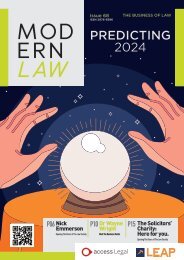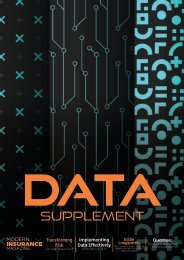Modern Insurance Magazine Issue 60
This issue features... Insight: Every Cloud Has A Silver Lining, by Tim Yeates, Co-Founder, Carbon1 Ltd. Interview: Modelling Modern Risk with Dr Kirsten Mitchell-Wallace, Director of Portfolio Risk Management, Lloyd’s of London Interview: Searching for Answers with Iain Willis, Research Director, Gallagher Research Centre Editorial Board: Find out what our editorial board panel of experts have to say in this edition of Modern Insurance Magazine A Final Word with Steve White, Chief Executive, British Insurance Brokers' Association (BIBA) Is it time for Risk Managers to rethink their role in the Climate Crisis? by François Lanavère, Head of Strategic Partnerships, AXA Climate Associations Assemble: Modern Insurance’s panel of resident associations outline the burning issues in insurance Just a Thought with Eddie Longworth - Building Trust through Responsible AI in Claims: Championing a Voluntary Code of Conduct Making Efficiency Gains in Subsidence Claims, by Chris Carlton MRICS, New Business & Key Account Director, Geobear Chemistry for a Sustainable Future: Q&A with Grant Dempsey, Sales Manager - Distribution, BASF Automotive Refinish UK & Ireland Industry Collaboration: Working together to provide the best mobility solution, with James Roberts, Business Development Director, Insurance, Europcar Mobility Group UK Thinking Upside Down: Mind the Protection Gap, by Ashley Preece, Product Owner, Claim Technology In Conversation with… Neil Garrett, UK, South Africa & Nordics Sales Director, Solera | Audatex A New Climate for Claims, from I Love Claims / ARC 360 10 Mins with… Ola Jacob, Independent Insurance Advisor In Celebration: Modern Claims Awards 2023 Insur.Tech.Talk - Interviews with Stephen Weinstein, Former Chair of the Bermuda Business Development Agency; Bill Churney, President, Extreme Event Solutions, Verisk; Jacqui LeGrand, CEO, Maptycs; Heather H. Wilson, Chief Executive Officer, CLARA Analytics Insur.Tech.Talk Editorial Board - Experts from within the insurtech sector and beyond join us once more to share their unique insights!
This issue features...
Insight: Every Cloud Has A Silver Lining, by Tim Yeates, Co-Founder, Carbon1 Ltd.
Interview: Modelling Modern Risk with Dr Kirsten Mitchell-Wallace, Director of Portfolio Risk Management, Lloyd’s of London
Interview: Searching for Answers with Iain Willis, Research Director, Gallagher Research Centre
Editorial Board: Find out what our editorial board panel of experts have to say in this edition of Modern Insurance Magazine
A Final Word with Steve White, Chief Executive, British Insurance Brokers' Association (BIBA)
Is it time for Risk Managers to rethink their role in the Climate Crisis? by François Lanavère, Head of Strategic Partnerships, AXA Climate
Associations Assemble: Modern Insurance’s panel of resident associations outline the burning issues in insurance
Just a Thought with Eddie Longworth - Building Trust through Responsible AI in Claims: Championing a Voluntary Code of Conduct
Making Efficiency Gains in Subsidence Claims, by Chris Carlton MRICS, New Business & Key Account Director, Geobear
Chemistry for a Sustainable Future: Q&A with Grant Dempsey, Sales Manager - Distribution, BASF Automotive Refinish UK & Ireland
Industry Collaboration: Working together to provide the best mobility solution, with James Roberts, Business Development Director, Insurance, Europcar Mobility Group UK
Thinking Upside Down: Mind the Protection Gap, by Ashley Preece, Product Owner, Claim Technology
In Conversation with… Neil Garrett, UK, South Africa & Nordics Sales Director, Solera | Audatex
A New Climate for Claims, from I Love Claims / ARC 360
10 Mins with… Ola Jacob, Independent Insurance Advisor
In Celebration: Modern Claims Awards 2023
Insur.Tech.Talk - Interviews with Stephen Weinstein, Former Chair of the Bermuda Business Development Agency; Bill Churney, President, Extreme Event Solutions, Verisk; Jacqui LeGrand, CEO, Maptycs; Heather H. Wilson, Chief Executive Officer, CLARA Analytics
Insur.Tech.Talk Editorial Board - Experts from within the insurtech sector and beyond join us once more to share their unique insights!
Create successful ePaper yourself
Turn your PDF publications into a flip-book with our unique Google optimized e-Paper software.
FEATURES<br />
Making Efficiency<br />
Gains in<br />
Subsidence Claims<br />
A critical aspect concerning subsidence claims revolves around the<br />
timeliness of their resolution. On average, a subsidence insurance<br />
claim can take 18-24 months to conclude. Subsidence claims, being<br />
relatively complex, demand thorough investigations in order to devise<br />
appropriate solutions. In the wake of the surge in 2018, out of the<br />
40,000 successful insurance claims, only half had been resolved<br />
within a two-year timeframe. Given the 2022 summer heat surge<br />
that the insurance sector experienced, it’s possible that it could<br />
be 2024 before some of the claims from last summer are settled.<br />
The claims process commences when the<br />
customer notifies their insurer about the<br />
presence of cracks or movement in their<br />
property. At this stage, the insurer will<br />
handle the claim in-house, or they will<br />
assign a loss adjuster to handle the claim<br />
on their behalf. The adjuster conducts a<br />
comprehensive inspection, organising a site<br />
investigation (SI) and monitoring program<br />
if appropriate to do so, before reporting<br />
their findings to both the insurer and the<br />
customer. After analysing the results, the<br />
adjuster determines whether additional<br />
information is required and looks to propose<br />
a repair solution and programme of works<br />
for the claim.<br />
The response to claims was efficiently<br />
coordinated using video technology. By<br />
meticulously analysing available information,<br />
Geobear could design and undertake a<br />
ground improvement scheme within 90 days<br />
of claim notification. Using an approach that<br />
only takes an average of 1-2 days to complete<br />
on-site, Geobear can stabilise and strengthen<br />
the subsoil beneath affected foundations,<br />
effectively halting further movement. This<br />
innovative approach eliminates the need<br />
for prolonged and complex investigations,<br />
monitoring, and mitigation phases - enabling<br />
the insurer and loss adjuster to proceed<br />
directly to final superstructure repairs.<br />
The key to all of this lies in expediting<br />
the claims process. Enhancing efficiency<br />
throughout the process reduces<br />
administrative time and uncertainty, leading<br />
to improved customer understanding and<br />
satisfaction.<br />
Efficiency improvements in subsidence<br />
claims can be achieved by working in<br />
partnership with insurers and loss adjusting<br />
clients. Geobear serves as a case study<br />
in efficiency improvement, benefitting all<br />
stakeholders involved through an innovative<br />
approach to resolving subsidence issues.<br />
Subsidence repair contractor Geobear<br />
worked with a Top 10 UK insurer and leading<br />
global loss adjuster to revolutionise the<br />
subsidence claim lifecycle by aiming to<br />
reduce the time taken for such claims by<br />
one year, all without incurring additional<br />
costs. Research indicated that costs rose<br />
as claims extended beyond 90 days, while<br />
customer satisfaction declined. However, it<br />
was found that these outcomes could largely<br />
be avoided. Armed with this understanding,<br />
the partnership collaborated to develop, test<br />
and implement an innovative solution for<br />
subsidence claims.<br />
The solution incorporated ‘smart triaging’,<br />
resulting in a streamlined claims process<br />
and a novel approach to repair. This new<br />
methodology was rapid and non-invasive,<br />
effectively curtailing ground movement<br />
to allow prompt commencement of the<br />
repair phase.<br />
Within a remarkably short timeframe of just<br />
six months, the partnership successfully<br />
devised an entirely new approach to<br />
managing subsidence claims. By minimising<br />
the number of works in progress, adjusters<br />
could concentrate their resources on a select<br />
number of claims, enabling the delivery<br />
of a superior level of customer service.<br />
This reduction in overall claims volumes<br />
alleviated pressure on the extended supply<br />
chain, ensuring smooth operations. Complex<br />
claims were also resolved at an earlier stage,<br />
reducing internal administrative costs and<br />
emotional distress for the policyholder.<br />
In addition, the Geobear solution eliminates<br />
the necessity for tree removal, safeguarding<br />
the surrounding community environment.<br />
Furthermore, homes are stabilised with the<br />
treatment, accompanied by a market leading,<br />
insurance backed guarantee and a certificate<br />
of structural adequacy to provide that extra<br />
layer of reassurance.<br />
Collaboration within the supply chain delivers<br />
unparalleled benefits to customers. Given<br />
the increasingly dry climate in the UK, the<br />
likelihood of subsidence surges has risen<br />
from 10% to 25%. To prepare for the growing<br />
probability of such events, a proactive and<br />
collaborative approach must be fostered.<br />
Building efficiency today ensures timely,<br />
cost-effective, and satisfactory outcomes for<br />
tomorrow’s customers.<br />
Chris Carlton,<br />
MRICS, New Business &<br />
Key Account Director, Geobear<br />
MODERN INSURANCE | 45

















